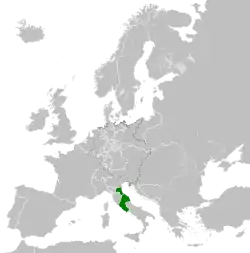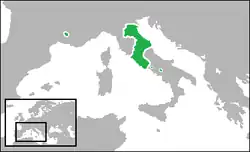Papal States
State of the Church Stato della Chiesa Status Ecclesiasticus | |||||||||||||||||||||||
|---|---|---|---|---|---|---|---|---|---|---|---|---|---|---|---|---|---|---|---|---|---|---|---|
| 754–1870 Interregna (1798–1799, 1809–1814 and 1849) | |||||||||||||||||||||||
 Coat of arms until 19th century
| |||||||||||||||||||||||
| Anthem: | |||||||||||||||||||||||
 The Papal States in 1815 after the Napoleonic Wars | |||||||||||||||||||||||
 | |||||||||||||||||||||||
| Capital | Rome | ||||||||||||||||||||||
| Common languages | Latin, Italian, Occitan | ||||||||||||||||||||||
| Religion | Roman Catholic | ||||||||||||||||||||||
| Government | Theocratic absolute elective monarchy | ||||||||||||||||||||||
| Pope | |||||||||||||||||||||||
• 754–757 | Stephen II (first) | ||||||||||||||||||||||
• 1846–1870 | Pius IX (last) | ||||||||||||||||||||||
| Cardinal Secretary of State | |||||||||||||||||||||||
• 1551–1555 | Girolamo Dandini (first) | ||||||||||||||||||||||
• 1848–1870 | Giacomo Antonelli (last) | ||||||||||||||||||||||
| Prime Minister | |||||||||||||||||||||||
• 1848 | Gabriele Ferretti (first) | ||||||||||||||||||||||
• 1848 | Giuseppe Galletti (last) | ||||||||||||||||||||||
| History | |||||||||||||||||||||||
• Establishment | 754 | ||||||||||||||||||||||
| 781 | |||||||||||||||||||||||
• Treaty of Venice (independence from the Holy Roman Empire) | 1177 | ||||||||||||||||||||||
• 1st disestablishment | February 15, 1798 | ||||||||||||||||||||||
• Schönbrunn Palace Declarations | May 17, 1809 | ||||||||||||||||||||||
• 2nd disestablishment | September 20, 1870 | ||||||||||||||||||||||
| February 11, 1929 | |||||||||||||||||||||||
| Population | |||||||||||||||||||||||
• 1853[1] | 3,124,668 | ||||||||||||||||||||||
| Currency |
| ||||||||||||||||||||||
| |||||||||||||||||||||||
| Today part of | |||||||||||||||||||||||
|}
The Papal States, officially the State of the Church (Italian: Stato della Chiesa, Italian pronunciation: [ˈstato della ˈkjɛːza]; Latin: Status Ecclesiasticus;[2] also Dicio Pontificia), were a series of territories in the Italian Peninsula under the direct sovereign rule of the Pope, from the 8th century until 1870.
By 1861, much of the Papal States' territory had been conquered by the Kingdom of Italy. In 1870, the Pope lost Lazio and Rome and had no physical territory at all, except the Vatican.
Related pages
- History of Rome
- Donation of Constantine
- Italian unification
References
- Statistica della popolazione dello Stato pontificio dell'anno 1853 (PDF). Ministero del commercio e lavori pubblici. 1857. p. XXII. Archived from the original (PDF) on 2 March 2018. Retrieved 1 March 2018.
- Frederik de Wit, "Status Ecclesiasticus et Magnus Ducatus Thoscanae" (1700)
Other websites
This article is issued from Wikipedia. The text is licensed under Creative Commons - Attribution - Sharealike. Additional terms may apply for the media files.
.svg.png.webp)